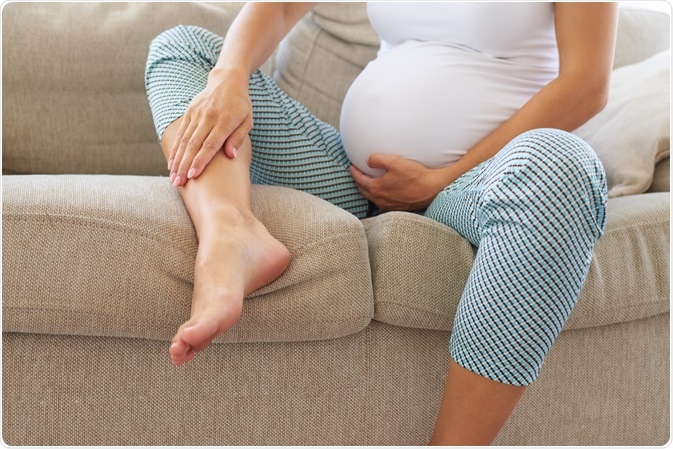Many changes occur to the body throughout pregnancy and, as a result, women who are pregnant are more likely to be affected by certain foot conditions.

Image Credit: ArtFamily / Shutterstock.com
Flat feet
The most common foot-related symptom reported during pregnancy is foot pain, which usually results from flattening of the feet. The characteristics of the pain can vary widely, from a dull ache to a sharp or throbbing pain.
This occurs because the body weight of a woman increases significantly during pregnancy and it is distributed around the body differently as compared to other types of weight gain. Specifically, the arch of the foot can flatten out and the feet roll inwards when walking, which is a symptom known as over-pronation. This can cause movement to become very painful and place additional strain on the feet, calves and back. Changes to the relaxin hormone during pregnancy are also thought to be associated with causing these effects.
To reduce over-protonation and the resulting pain, it is important for pregnant women to wear appropriate footwear that supports the arch of the foot. Orthotics that are designed to correct flattening of the feet can also be helpful in some cases.
Swelling and edema
Swelling of the feet, also known as edema, usually presents in the second or third trimester of pregnancy. This occurs as a result of the increased blood volume and blood pressure, which leads to water retention and swelling in the legs and feet.
To reduce the swelling, it is important to keep moving regularly to move the circulation of blood and stop the fluid from pooling in the legs and feet. Taking short breaks to walk around during long periods of sitting can be helpful, in addition to raising the feet on a stool when sitting. Staying hydrated and reducing salt intake can also aid in reducing both blood volume and edema.
Ingrown toenails
Ingrown toenails are more common in pregnant women due to the changes in the size, shape, and positioning of the foot. The nail is more likely to be pushed into the surrounding skin with tight-fitting shoes or socks, and it can be difficult to trim the toes correctly without help.
Regular salt-water baths can help to relieve the pain and the softened skin can gently push back and away from the nail to improve the condition.
Hot or burning sensations
Some women who are pregnant also experience hot or burning sensations in their feet, which result from hormonal changes that cause an increase in body temperature. These sensations can be heightened when the woman is fatigued and, in some cases, may inhibit sleep.
Cracked heels
Cracked heels are also a common complaint, which is caused by changes in weight and posture associated with pregnancy. The heels tend to expand, leading to cracks if the skin becomes too dry.
Leg Pain During Pregnancy - Podiatrist Georgina Tay, East Coast Podiatry
Management of foot conditions
There are a number of treatment options that can help to reduce the symptoms associated with foot conditions in pregnancy. These include:
- Elevating the feet
- Wearing appropriate footwear
- Wear seamless socks that do not constrict circulation
- Take regular breaks to stretch legs during long periods of sitting
- Keep physically active with low-intensity exercise (i.e., walking)
- Staying hydrated
- Avoid foods high in salt
Over-pronation of the feet can be managed by opting for appropriate footwear and the use of orthotics. Shoes should be comfortable with extra support and shock absorption, and orthotics can give additional support to the arch and heel of the foot to correct the positioning. A podiatrist can help in the process to examine the foot positioning and make recommendations as to the most appropriate orthotic for the situation.
References
Further Reading
Last Updated: Sep 24, 2022